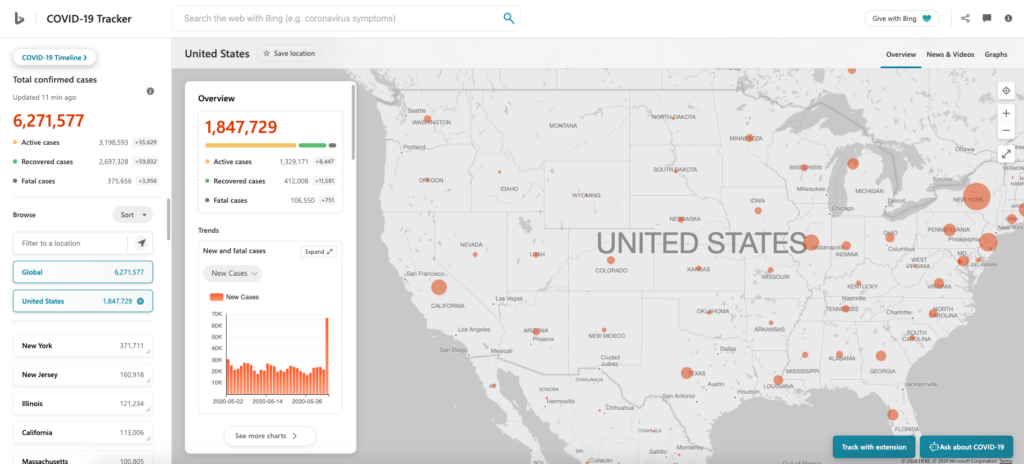By Maggie Mick, CSG chief advancement officer
Following natural disasters and in times of national crisis, America’s private sector steps up to aid the states. We are proud of the herculean efforts of CSG Leadership Circle and Associates, our private sector members, as we together combat COVID-19.
Associates in Action articles highlight CSG Associates’ philanthropic efforts and public-private partnerships throughout the states.
Seattle was one of the first outbreak hotspots in the U.S. of the novel coronavirus in early March. Microsoft, a CSG Associate member, calls the region home and quickly mobilized its resources, people and innovations to battle COVID-19 in its home state, across the country and throughout the world. These efforts include the development of mapping portals to track the virus, support for researchers seeking solutions to the health crisis, utilization of technology to monitor ICU patients and providing technology accessibility to Americans working from home.
Tracking the Virus
Within a week of the World Health Organization declaring COVID-19 a pandemic on March 11, Microsoft’s Bing team launched a web portal for tracking coronavirus infections across the globe. The website is bing.com/covid [MM1] provides up-to-date infection statistics for each country. An interactive map provides users to click on the country to see the specific number of cases and related articles from a variety of publishers.

Microsoft AI for Health Leads on COVID-19 Innovations
On Jan. 29, 2020, Microsoft announced the launch of AI for Health, an initiative to advance the health of people and communities around the world. The five-year commitment was created to empower nonprofits, researchers and organizations with AI and data science tools. The commitment was timely as AI for Health has collaborated with numerous partners as it considers resources and new innovations to combat COVID-19.
The AI for Health team is working with the Institute for Health Metrics and Evaluation at the University of Washington to create data visualizations that help researchers better understand and respond to COVID-19.
Microsoft also expanded its existing partnership with Adaptive Biotechnologies Corporation, which maps population-wide adaptive immune responses to diseases at scale, in order to study COVID-19. The data collected and analyzed will be made freely available to any researcher, public health official or organization around the world via an open data access portal.
In addition, The Centers for Disease Control and Prevention launched in March a COVID-19 assessment bot to help initially screen Americans who are concerned they are suffering from symptoms connected to the novel coronavirus. The bot was developed in partnership with Microsoft’s Healthcare Bot service, which the company is offering to those “on the front lines” free of charge to help eliminate bottlenecks in the contemporary health system of patients hoping to make sense of their symptoms.
Called Coronavirus Self-Checker, the conversational bot on the agency’s website gauges the risk factors and symptoms of people who engage with it and can offer insights into next moves they should consider in support of their health.
New York State’s Technology SWAT Team
In another coronavirus hot zone, New York state officials deployed a first-in-the-nation technology partnership with leading technology companies, including Microsoft. The technology SWAT Team will support New York State’s Office of Information Technology Services and the Department of Financial Services. The Tech SWAT Team projects will support important projects across New York State agencies, including those being implemented by the Departments of Health and Labor. Almost every facet of New York’s response effort has a technological component and this new team supports the state’s response to this unprecedented health crisis.
In April, the SWAT Team released its first tool. The diagnostic tool is a web-based self-diagnostic survey that asked users if they were suffering from any of the known symptoms of COVID-19 — including high fever, difficulty breathing or a persistent dry cough — or if they were knowingly been in contact with people who have been diagnosed. Depending on a person’s symptoms and proximity to COVID-19 patients, the tool can help patients schedule a lab test to determine if they have been infected with the novel coronavirus.
New York State Office of Information Technology Services worked with Microsoft to develop the diagnostic, which officials said has — as of April 16 — already been used by more than 100,000 residents.
Microsoft Teams Sees Surge During Stay-At-Home Orders
By the end of March, millions of Americans had been asked by their state’s chief executive officers to stay-at-home. According to the New York Times, at least 316 million people in at least 42 states, the District of Columbia and Puerto Rico have been asked to stay-at-home.
With millions of American workers attempting to convert their homes to remote offices, Microsoft Teams has become a go-to resource for many companies and individuals to remain connected to their colleagues and advance their work. Microsoft Teams is a communication and collaboration platform that combines persistent workplace chat, video meetings, file storage and application integration.
Worldwide, Microsoft reported a 40% increase in usage from 32 million to 44 million daily users in March.
While the majority of state legislatures adjourned or paused session due to the COVID-19 outbreak, local governments have already turned to technologies like Microsoft Teams to conduct public meetings. Both Tennessee and Nebraska issued executive orders allowing local governments to hold virtual public meetings. Tenness Gov. Bill Lee’s order suspended portions of the state’s Open Meeting Act, often referred to as the Sunshine Law, to allow leaders to continue handling essential government business without requiring leaders to be physically present, especially as current guidelines call for gatherings to be limited to 10 people or less.
As this crisis continues to disrupt and technology utilization needs continue for American life to move forward, state leaders may be forced to consider virtual meeting options to advance business and operations.
For more information on Microsoft’s efforts and partnership with state governments during this pandemic, please visit: news.microsoft.com/covid-19-response/

